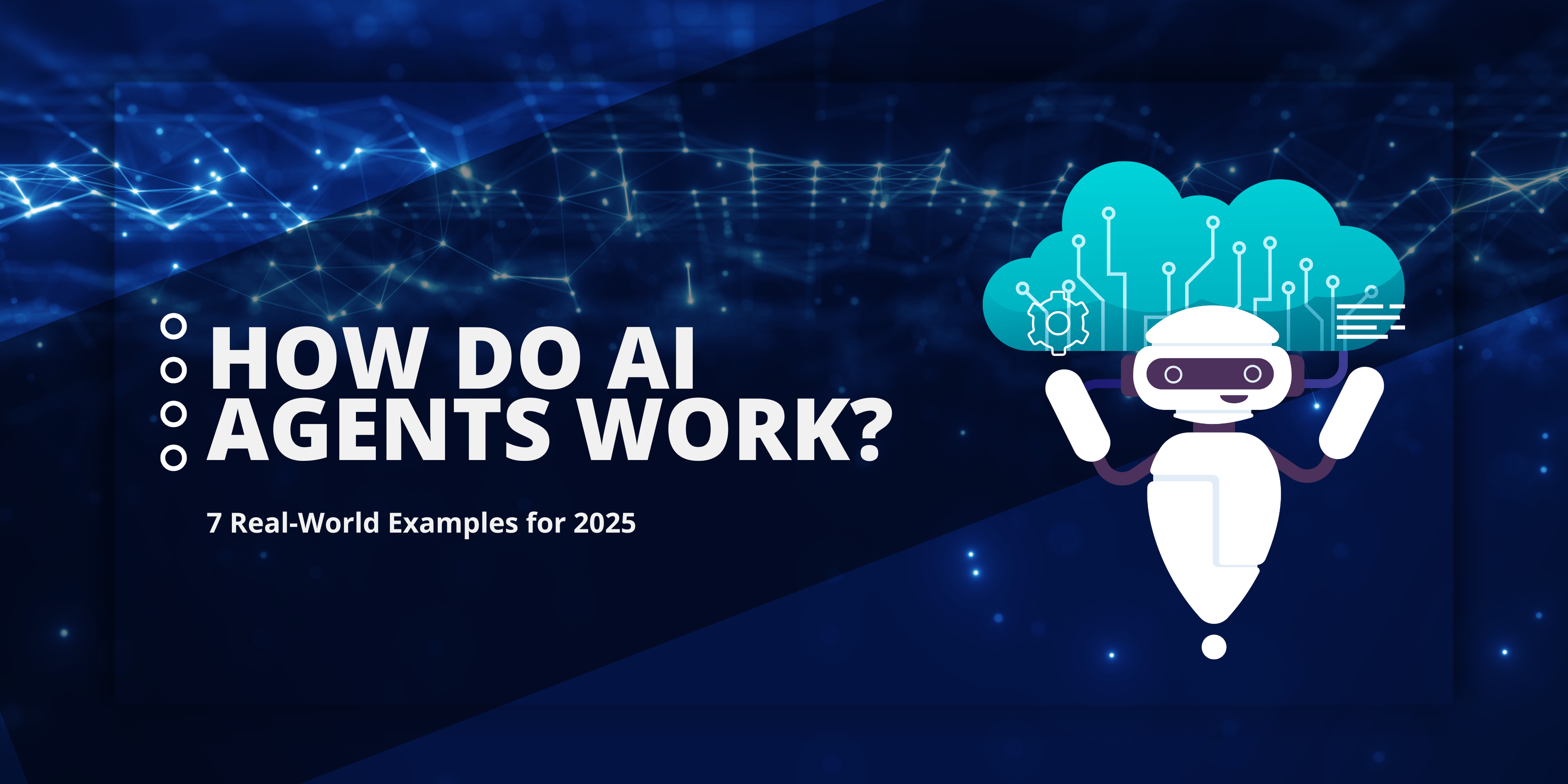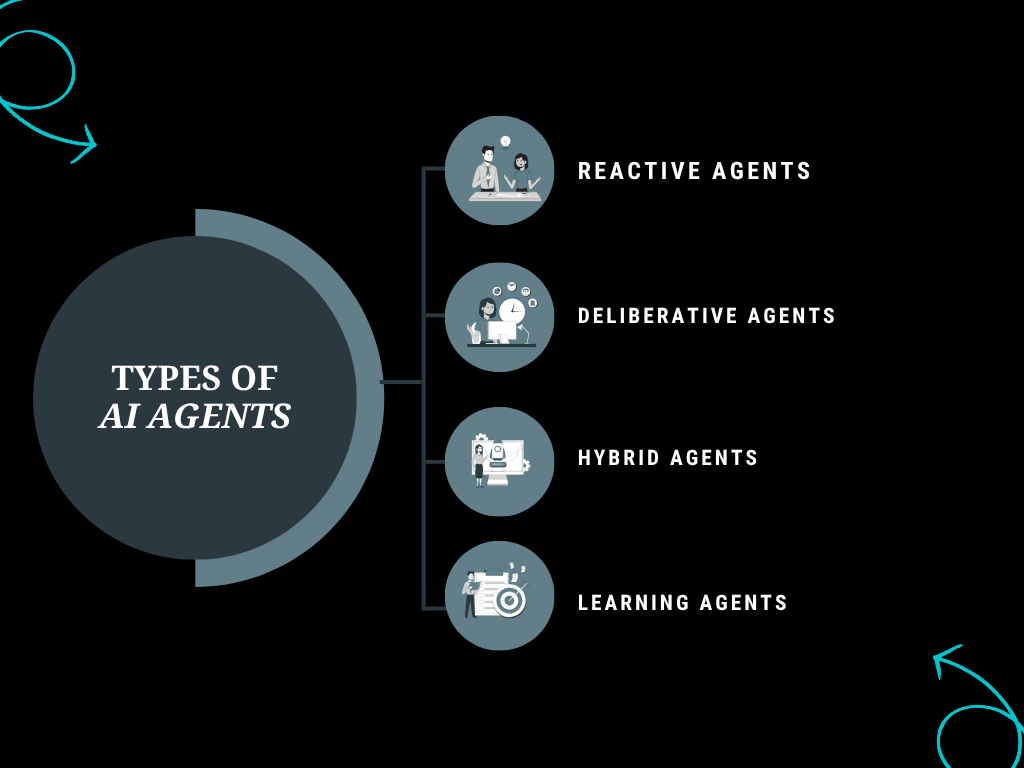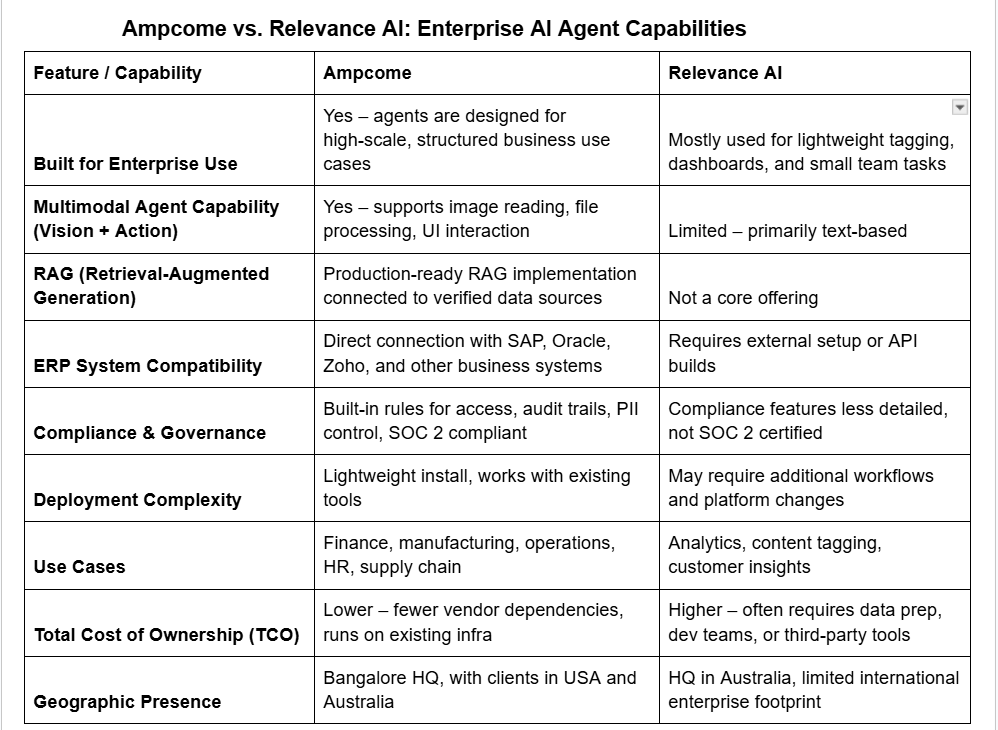
How do AI Agents Work? 7 Real-World Examples for 2025

Enterprise leaders are asking: Can AI agents deliver real value while keeping things safe and compliant?
In 2025, many professionals from developers to government staff use AI agents to handle repetitive tasks. These agents do more than answer questions. Using AI agents enables organizations to automate complex tasks that go beyond simple question answering, such as coordinating workflows, managing data, and providing customer service through chatbots.
As companies rush to save time and reduce errors, AI agents are quickly becoming the go-to solution. These autonomous systems can complete tasks on their own, not just assist with them, by reasoning, planning, and learning to adapt to new challenges.
Automating complex tasks with AI agents allows enterprises to boost efficiency, streamline operations, and tackle sophisticated problems that previously required significant human effort.
Here’s how do AI agents work in the real world.
What's an AI Agent?
An AI agent is more than just a chatbot that answers questions. It’s software designed to do things like sending emails, running scripts, filling forms, fixing code, or guiding robots. An AI agent is a type of intelligent agent capable of reasoning and acting autonomously.
These agents can move through websites, click buttons, write programs, test products, analyze data, and more.
A common application is the customer service chatbot, which uses algorithms and data inputs to improve customer interactions.
Most people don’t realize how much they can handle. Instead of just talking, these agents act. They are ending repetitive tasks and making life simpler for professionals in software, government, factories, and offices. While AI agents can manage complex workflows, they are also capable of performing simple tasks such as responding to prompts or basic data entry.
Types of AI Agents: Reactive, Deliberative, Hybrid, and Learning
AI agents come in several distinct types, each with unique strengths and ideal use cases.
Understanding these types is key to selecting the right agent for your business needs, whether you’re automating routine tasks or tackling complex workflows.

Reactive Agents
Reactive agents are the simplest form of AI agent. They operate based on the current state of their environment, responding instantly to inputs using predefined rules. These simple reflex agents don’t maintain any memory of past interactions or internal state—they simply match conditions to actions.
For example, a basic customer service chatbot that provides canned responses to specific keywords is a reactive agent. While limited in scope, reactive agents excel at well-defined tasks where quick, rule-based responses are needed.
Deliberative Agents
Deliberative agents take things a step further. They maintain an internal model of the environment, allowing them to reason, plan, and make informed decisions. Model-based reflex agents are a classic example, using their internal model to predict outcomes and choose the best course of action.
This makes deliberative agents ideal for scenarios where context and history matter, such as workflow automation or process optimization in business operations. By leveraging their internal state, these agents can handle more complex tasks and adapt to changing conditions.
Hybrid Agents
Hybrid agents combine the best of both worlds, blending the fast response of reactive agents with the thoughtful planning of deliberative agents. This dual approach enables hybrid agents to react quickly to immediate changes while also considering longer-term goals and strategies.
Hybrid agents are particularly useful in dynamic environments where both immediate action and strategic planning are required, such as supply chain management or real-time customer engagement.
Learning Agents
Learning agents are designed to improve over time. By leveraging machine learning and natural language processing, these agents can adapt their behavior based on experience, learning from past interactions and new data.
Learning agents are at the heart of many advanced AI applications, from robotics to generative AI and natural language interfaces. Their ability to update their internal models and refine their decision-making makes them invaluable for tasks that evolve or require continuous improvement.
By understanding the different types of AI agents—reactive, deliberative, hybrid, and learning—you can better match agent technology to your organization’s needs, whether you’re automating simple tasks or building intelligent agents capable of handling complex, ever-changing environments.
Understand Enterprise AI Agents and How They Differ from Consumer Tools
While basic automation tools and chat assistants are becoming common, Ampcome is working on something deeper.
They include vision, action capabilities, which means they can process images, dashboards, scanned documents, and visual layouts.
For example, reading an invoice image and updating a report. Or spotting missing fields in scanned forms and flagging them before submission.
Most people using autonomous AI today don’t realize how important this is. When accuracy and data traceability matter, RAG helps the agent stay grounded in PDFs, internal wikis, knowledge bases, or structured files.
Consumer tools often help with simple prompts, reminders, or text replies. In contrast, enterprise AI agents operate with deeper system-level access, structured logic, and production accountability. Here's how the difference plays out in practice:
- System Interoperability
Enterprise agents connect with platforms like SAP, Salesforce, ServiceNow, or custom-built APIs. Consumer tools typically work within closed environments or standalone apps.
- Multimodal Input and Output
Enterprise agents process not just text, but also scanned documents, screenshots, system logs, spreadsheets, and structured databases. This allows them to work across processes like invoice checks, compliance reporting, and logistics tracking.
- Retry Logic and Recovery
When something breaks, enterprise-grade agents can reattempt, log the failure, and notify a team. Consumer tools often stop at error messages or require manual restart.
- Data Access Controls
Role-based access, redaction rules, and audit logs are standard in enterprise deployments. Consumer tools rarely support these protocols.
- RAG (Retrieval-Augmented Generation)
Advanced enterprise agents combine outputs from large models with approved internal content such as SOPs, contracts, or data sheets. This limits incorrect answers and keeps responses within company policies.
- Deployment and Monitoring at Scale
Enterprise platforms support agent orchestration, health checks, and telemetry dashboards. This allows for cross-team tracking and technical oversight.
- Compliance Standards
Enterprise AI agents often follow SOC 2, HIPAA, or ISO frameworks. Consumer AI rarely meets such standards.
- TCO Awareness
Enterprise deployments factor in infrastructure use, agent maintenance, support load, and licensing. The cost model is calculated across months, not per action.
The Core Structure Behind Every Agent
So, how do AI agents work today?
Here’s a look at the architecture most teams are using: AI agents process information by interpreting, analyzing, and utilizing data inputs to autonomously perform tasks within their operational workflows.
1. Language Model (LLM) as the Brain
Every AI agent starts with a large language model like Claude, GPT-4o, or Gemini. This is where the thinking happens. The intelligent automation model takes instructions in plain language and figures out what actions to take.
2. Memory Layer for Context
Unlike older systems, today's agents remember things. They hold on to past chats, decisions, and even patterns in behavior. Vector databases like Pinecone or Weaviate are commonly used to store these memories.
3. Tools & Plugins Layer
The autonomous AI systems use calculators, calendars, email accounts, search engines, or even spreadsheets. These are called tools or plugins. The agent checks the task, picks the right tool, and runs it.
4. Agent Framework (like CrewAI or AutoGen)
This part is the control room. It breaks down a big job into smaller tasks and assigns them to agents. Tools like CrewAI, AutoGen, and MetaGPT are widely used in 2025 to set up these multi-agent teams.
5. Workflow Rules and Logic
Every task the agent does follows a sequence. What to do first, what to check after, when to stop, when to ask for help, these rules are built into the system.
If you create your own AI agent using a no code AI agent builder, this is where you define the workflow.
6. Human Feedback & Audit Logs
Since these intelligent automation platforms act on behalf of real users, teams add ways to track what they did. They log their steps, explain their actions, and ask for human input when needed. This is now a standard part of how AI agents work, especially in banks, legal firms, and government tasks.
Enterprise AI Agent Implementation Strategy
Deploying AI agents in enterprise environments requires structured planning, system compatibility, and governance readiness.
1. Identify high-friction processes with repetitive, rules-based tasks.
2. Define input-output flows, edge cases, and escalation logic.
3. Select an enterprise-ready platform like Ampcome with ERP and API-level integration support.
4. Pilot the agent within a production-like sandbox using live datasets.
5. Implement access controls, audit trails, and data handling policies.
6. Measure impact using KPIs such as hours saved, error rates, and task throughput.
7. Scale horizontally, adding more agents across departments as adoption increases.
Why No-Code Tools Matter In Building An AI Agents
A growing trend is no code AI agent builder tools. These let users create their own AI agent using drag-and-drop blocks.
Someone can build a travel booking assistant by connecting email tools, calendar apps, and booking sites.
For small business owners or office teams, this means they can set up AI workflows without hiring engineers. No-code AI agent builders are removing barriers, making automation accessible to anyone who can imagine a task and connect the dots.
Agent Performance and Optimization: Metrics, Tuning, and Best Practices
Optimizing the performance of AI agents is essential for maximizing their value in business operations.
Whether you’re deploying autonomous AI agents for routine tasks or building custom agents for complex workflows, focusing on performance, responsible AI, and continuous improvement will ensure your investment delivers real results.
Key Metrics for AI Agent Performance
To evaluate how well your AI agents work, it’s important to track relevant metrics. Common measures include accuracy, precision, recall, F1 score, and mean squared error, depending on the specific tasks your agents perform.
For example, a customer service chatbot might be evaluated on response accuracy and customer satisfaction, while a data analysis agent could be measured by precision and recall in identifying relevant data.
Tuning and Optimization
Agent performance can often be improved by tuning parameters such as learning rates, exploration strategies, and model architectures. Techniques like grid search, random search, or Bayesian optimization help identify the best settings for your machine learning models or large language models.
Regularly updating your agents with sufficient data and retraining them as new information becomes available ensures they stay effective in dynamic environments.
Real-World Applications of AI Agents and Platforms
1. xAI – Grok for Government
xAI, founded by Elon Musk, recently launched a set of AI tools known as Grok for Government. These tools are designed to support government operations at local, state, and national levels.
What makes it unique is that xAI’s models, like Grok 4, are now being used in government systems where previously only manual or slow software was used.
These intelligent automation tools help government departments manage complex data, write reports faster, and get better insights.
2. BrowserStack AI
BrowserStack, a well-known testing company, has added a group of AI agents across its platform. It is made for 90% time savings of the employees.
The intelligent automation platform includes five tools:
- Writes test cases from product documents
- Turns them into actual test scripts, a self-fixing tool that repairs broken tests
- Find accessibility problems
- Checks for visual changes in design
BrowserStack says these tools can save teams up to 90% of their time on test creation. Everything works inside BrowserStack’s own platform, making it easier for teams to use.
3. Google Gemini CLI
Google is rolling out Gemini CLI, a command line tool powered by AI, which helps developers get work done using simple language. Traditionally, developers had to remember hundreds of commands and deal with complex tools.
With Gemini CLI, they can now just tell the computer what they want to do, and the tool handles the rest. From writing new code to fixing existing issues, Gemini CLI understands the context of your entire project.
4. OpenAI Codex CLI
OpenAI’s Codex CLI helps software engineers manage several tasks at the same time. Instead of running multiple tools, Codex CLI does it all in one space.
It runs in a sandbox environment that already contains your code, so it can make better decisions based on what it sees.
5. Claude 3.5 by Anthropic
Anthropic’s Claude 3.5 is a special type of AI agent that acts almost like a human working on a computer. It can click buttons, log in to systems, navigate websites, and collect information.
Businesses use Claude for form submissions, backend data entry, and general system navigation.
6. NVIDIA Eureka
Eureka, built by NVIDIA, is made to train robots by watching how they perform. It uses feedback and practice to improve how machines behave, especially in physical spaces.
Eureka uses reinforcement learning, which means it learns what works and what doesn’t over time. Autonomous AI systems help in industries like manufacturing and logistics, where machines need to do physical tasks correctly.
7. Ampcome
Ampcome is a newer name in the AI space, but it's quickly gaining attention for its practical, enterprise-ready AI agents that simplify real business tasks. It's multi-cloud deployment approach differs from single-cloud solutions offered by competitors.
Unlike many others, Ampcome isn’t trying to impress with complicated tech. It builds tools that help companies get work done faster, especially across large teams.
From report automation for managers to data extraction for analysts, Ampcome’s agents can be applied directly to save teams up to 90% of their time.
Ampcome runs from its head office in Bangalore and also works with clients in the USA and Australia. With a growing footprint, it brings a strong product-engineering mindset to every conversation.

Unlike consumer-focused platforms, Ampcome's enterprise agents connect directly with ERP systems already in place and follow strict SOC 2 compliance. This reduces both complexity and risk while allowing AI agents to actually support live, business-critical workstreams.
Why AI Agents Belong in Your Core Business Processes
AI is becoming part of how real businesses move faster and stay ahead. But for it to actually help, it has to live inside your actual workflows.
That’s where Ampcome fits in.
Instead of building tools that work in isolation, we design AI agents that run alongside your teams, inside your actual processes. From order management in retail, to KYC automation in banking, to task routing in operations, our tools help teams save time and keep moving.
We work directly with CIOs, product heads, and tech teams to bring these agents to life. Every agent we create is built to solve a real job, not just show off what AI can do.
Multimodal AI Agents: Vision-Language Models in Action
Most AI pilots look affordable at first glance. But costs rise fast when teams realize they need additional infra, custom workflows, new tools, and dedicated AI experts. Ampcome works to reduce this risk. Their agents don’t need constant tuning or extra licenses.
Companies using Ampcome’s tools in production today have reported less dependency on external consultants, faster delivery cycles, and better handover between teams.
So while everyone’s talking about AI, Ampcome is changing how it works with multimodal agents, RAG in production, strong compliance controls, and a smarter way to think about TCO.
AI Agents vs Chatbots vs LLMs: What’s Really Different?
AI agents are now doing tasks from start to finish, almost like digital assistants with brains and hands.
That brings us to the big question: what are agents in Artificial Intelligence, and how are they different from chatbots or large language models (LLMs)?
Let’s break it down simply.
- Chatbots reply to prompts. They give answers, maybe even helpful ones, but they don’t take action.
- LLMs (like GPT or Claude) are trained to process language. They can write, explain, summarize, or generate, but they also stop where their text output ends.
- AI Agents don’t stop at replies. They open sites, run tasks, click buttons, write code, test systems, update files.
So when someone asks, “What is an agent in Artificial Intelligence?”, the answer is simple: It’s a smart system that acts.
The Ampcome AI Agent Maturity Model
Ampcome helps enterprises move from simple task automation to advanced AI agents that support core operations. Its AI Agent Maturity Model outlines five stages:
- Basic Automation – Agents handle repetitive tasks like email sorting or file extraction.
- Connected Tools – They work with systems like ERP or CRMs to automate frequent actions.
- Workflow Assistants – Agents follow logic, assign tasks, and manage steps across tools.
- Decision Support – They analyze data and provide structured business recommendations.
- Autonomous Operations – Agents run critical tasks independently with rules and oversight.
This intelligent automation platforms helps enterprises scale AI without chaos or confusion.
Calculating AI Agent ROI: A Framework for Enterprise Leaders
Ampcome’s research across 100+ enterprise deployments shows ROI comes from three areas:
- Time saved on manual processes
- System coverage across tools like ERP and internal platforms
- Governance, with built-in rules and controls
Use this formula to track value:
ROI = (Hours Saved × Labor Cost) + Delay Reduction – Deployment Costs
Unlike consumer platforms, Ampcome’s agents are built for enterprise use, connect with live business systems, and support SOC 2 compliance from day one.
Final Thoughts
So, what is an agent in Artificial Intelligence? Unlike basic automation tools, AI agents can write code, scan files, test products, click through systems, fix errors, and even retry when something fails.
By 2025, these agents are becoming a key part of how work gets done. They take charge of tasks that used to eat up hours. People are starting to interact with systems through intelligent action, not buttons and forms.
Download our Enterprise AI Agent Implementation Playbook to get started. Schedule a free AI agent ROI assessment with our team to see the potential in your workflows and get the best AI agent development services.
Ready to deploy AI agents in your enterprise? Contact Ampcome today.

Transform Your Business With Agentic Automation
Agentic automation is the rising star posied to overtake RPA and bring about a new wave of intelligent automation. Explore the core concepts of agentic automation, how it works, real-life examples and strategies for a successful implementation in this ebook.
More insights
Discover the latest trends, best practices, and expert opinions that can reshape your perspective
Contact us











